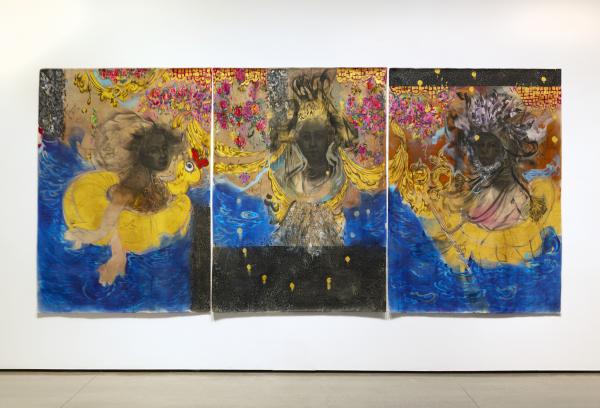In honor of Women’s History Month, we’re celebrating the contributions of women throughout art history, including artworks by women from LACMA’s collection.
This monumental triptych is a brilliant summation of Scherezade García’s concerns with history, hybridity, migration, and memory. An interdisciplinary artist, García moved from the Dominican Republic to New York in 1986 to attend Parsons School of Design. Her dual identity as an islander has made her keenly aware of the role of the ocean to connect and divide people. Water becomes the stage of her exuberant, color-filled compositions, and a vector of the diasporic experience of her own community and beyond. This “liquid highway,” as the artist has described it, bridges people, their hopes, and their dreams. But the fluid medium has also enabled and hampered a long history of migration in the Americas—often violent and perilous—including the transatlantic slave trade (which formally ceased in the 19th century) and in more recent times the sea journeys of countless Caribbean islanders to the United States in search of a better life. “I see water as an obstacle which we need to navigate and cross, as a mass of water that carries our history, memories, DNA,” García has said.
Throughout her career, García has been particularly interested in decoding the layering of history and people in Latin America, what she has pointedly described as a “hybrid salvation.” “Everything that I do and how I do it is very cohesive with. . . .my American experience, my Caribbean experience,” García has said. “I am a consequence of something that was very bloody but [that] also changed the world completely, transformed everything, hacked everything and made it anew.”

In this grand composition, the deep cobalt of the ocean links three ethereal yet resilient female figures adrift at sea. Anchored by a flotation ring, a motif that, along with lifejackets, appears in much of García’s work since the 1990s to symbolize the precariousness of modern migration, they embody the multiple cultures and geographies that have come to shape Latin America in postcolonial times.

The figure on the left sailing on a duck float (a symbol of U.S. capitalist consumerism and pop culture) stands for the African diaspora; the one in the center, with the peineta (hair comb) and mantilla (veil), for Spain and Europe with their long history of cultural blending. The decorative marks evoke Arabic calligraphy but resists any form of literacy—that is, they are not meant to be read or decoded with any degree of specificity. Finally, the figure on the right with a feathered headdress stands for the Americas. Though separate, they are entangled through a luminous, golden sash and the swirling waves.
This cultural intersectionality is further embodied by the cinnamon hue of the figures, which, according to the artist, results from mixing specific colors—white, black, yellow, red, and brown—and is therefore highly symbolic. In other words, this is a color that subsumes all others and represents the sameness—not the differences—of humankind. The figures are neither portraits nor types but rather an amalgam of the important women in García’s life that she conjures through the act of memory.
García’s works are meticulous and gestural in equal measure. She builds her compositions layer by layer and infuses them with energy and motion to echo the movement of people across time and space—physically and metaphysically. The attention paid to pattern and color is in part indebted to her early training in fashion design in Santo Domingo, and to her fascination with colonial churches. The artist has often remarked on how the Catholic Church used surface ornamentation to enthrall people and get its message across, and how she herself is not immune to this type of beauty. Her images resort to a parallel visual strategy of combining disparate elements to create a sense of what she calls “strange harmony,” bringing viewers into her universe. For her, this is a way of colonizing the colonizer.
Harvest of the Sea is the first work by this Caribbean artist to enter the collection, and was acquired through the generosity of the Contemporary@LACMA (C@L) acquisitions group. Learn about the other works acquired at the 2023 C@L acquisitions meeting on Unframed.



